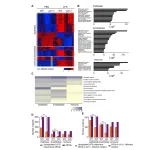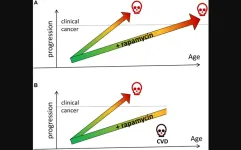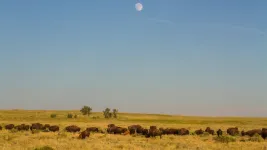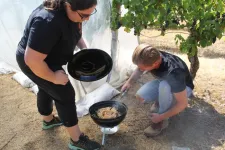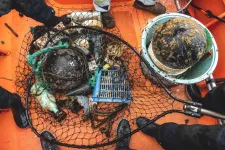(Press-News.org) New fossils in amber have revealed that beetles fed on the feathers of dinosaurs about 105 million years ago, showing a symbiotic relationship of one-sided or mutual benefit, according to an article published in Proceedings of the National Academy of Sciences of the United States of America today*.
The main amber fragments studied, from the Spanish locality of San Just (Teruel), contain larval moults of small beetle larvae tightly surrounded by portions of downy feathers. The feathers belonged to an unknown theropod dinosaur, either avian (a term referring to “birds” in wide sense) or non-avian, as both types of theropods lived during the Early Cretaceous and shared often indistinguishable feather types. However, the studied feathers did not belong to modern birds since the group appeared about 30 million years later in the fossil record, during the Late Cretaceous.
When looking at modern ecosystems, we see how ticks infest cattle, frogs capture insects with acrobatic tongues, or some barnacles grow on the skin of whales. These are just a few of the diverse and complex ecological relationships between vertebrates and arthropods, which have coexisted for more than 500 million years. The way that these two groups have interacted throughout deep time is thought to have critically shaped their evolutionary history, leading to coevolution. Nevertheless, evidence of arthropod-vertebrate relationships is extremely rare in the fossil record.
The larval moults preserved in the amber were identified as related to modern skin beetles, or dermestids. Dermestid beetles are infamous pests of stored products or dried museum collections, feeding on organic materials that are hard for other organisms to decay such as natural fibres. However, dermestids also play a key role in the recycling of organic matter in the natural environment, commonly inhabiting nests of birds and mammals, where feathers, hair, or skin accumulate.
“In our samples, some of the feather portions and other remains – including minute fossil faeces, or coprolites – are in intimate contact with the moults attributed to dermestid beetles and show occasional damage and/or signs of decay. This is hard evidence that the fossil beetles almost certainly fed on the feathers and that these were detached from its host,” explains Dr Enrique Peñalver, from the Geological and Mining Institute of Spain of the Spanish National Research Council (CN IGME-CSIC) and lead author of the study.
“The beetle larvae lived −feeding, defecating, moulting− in accumulated feathers on or close to a resin-producing tree, probably in a nest setting. A flow of resin serendipitously captured that association and preserved it for millions of years.”
“Three additional amber pieces each containing an isolated beetle moult of a different maturity stage but assigned to the same species were also studied, allowing a better understanding of these minute insects than what is usually possible in palaeontology,” says Dr David Peris, from the Botanical Institute of Barcelona (CSIC-Barcelona City Council) and co-author of the study. The most impressive, complete specimen was found in the amber deposit of Rábago/El Soplao in the northern Spain, roughly of the same age as San Just.
“It is unclear whether the feathered theropod host also benefitted from the beetle larvae feeding on its detached feathers in this plausible nest setting,” says Dr Ricardo Pérez-de la Fuente, from Oxford University Museum of Natural History and co-lead author of the study. “However, the theropod was most likely unharmed by the activity of the larvae since our data show these did not feed on living plumage and lacked defensive structures which among modern dermestids can irritate the skin of nest hosts, even killing them.”
**
Notes
(*) The paper “Symbiosis between Cretaceous dinosaurs and feather-feeding beetles” is published as open access in the journal Proceedings of the National Academy of Sciences of the United States of America (=PNAS). For accessing an embargoed copy of the original article, please refer to PNAS’ EurekAlert! press note at https://www.eurekalert.org/news-releases/985779
The international and multidisciplinary team comprised researchers from the Geological and Mining Institute of Spain of the Spanish National Research Council (CN IGME-CSIC), the Botanical Institute of Barcelona (IBB-CSIC), the University of Barcelona and the Institute for Research on Biodiversity (IRBio), the Complutense University of Madrid, the ‘Parque de las Ciencias’ of Andalusia, the Autonomous University of Madrid, and the Royal Academy of Exact, Physical and Natural Sciences (Spain); the American Museum of Natural History and the Natural History Museum of Los Angeles County (United States of America); the Senckenberg Research Institute (Germany); and Oxford University Museum of Natural History (United Kingdom).
Funding bodies: the project CRE, funded by the Spanish AEI/FEDER, UE Grant CGL2017-84419, the project PGC2018-094034-B-C22 (MCIU/AEI/FEDER, UE), the project CGL2014-52163, funded by the Spanish Ministry of Economy, Industry, and Competitiveness, the Secretary of Universities and Research of the Government of Catalonia and European Social Fund (2021FI_B2 00003), and the Consejería de Industria, Turismo, Innovación, Transporte y Comercio of the Gobierno de Cantabria through the public enterprise EL SOPLAO S.L.
For further information and images, please contact:
Dr Enrique Peñalver
Senior Researcher
Geological and Mining Institute of Spain of the Spanish National Research Council (CN IGME-CSIC)
e.penalver@csic.es
Dr David Peris
Beatriu de Pinós Postdoctoral Researcher
Botanical Institute of Barcelona
david.peris@ibb.csic.es
+34 650 069 697
Dr Ricardo Pérez-de la Fuente
Deputy Head of Research
Oxford University Museum of Natural History
ricardo.perez-de-lafuente@oum.ox.ac.uk
+44 01865 272971
Notes to editors
About Oxford University Museum of Natural History
Founded in 1860 as the centre for scientific study at the University of Oxford, the Museum of Natural History now holds the University’s internationally significant collections of entomological, geological and zoological specimens. Housed in a stunning Pre-Raphaelite-inspired example of neo-Gothic architecture, the Museum’s growing collections underpin a broad programme of natural environment research, teaching and public engagement.
www.oumnh.ox.ac.uk
www.morethanadodo.com
END
Fossils reveal the long-term relationship between feathered dinosaurs and feather-feeding beetles
Amber fragments preserve remains of feathers and larvae related to modern feather-feeding beetles in intimate contact
2023-04-17
ELSE PRESS RELEASES FROM THIS DATE:
Sea-level rise in southwest Greenland as a contributor to Viking abandonment
2023-04-17
Vikings occupied Greenland from roughly 985 to 1450, farming and building communities before abandoning their settlements and mysteriously vanishing. Why they disappeared has long been a puzzle, but a new paper from the Department of Earth and Planetary Sciences (EPS) determines that one factor – rising sea level – likely played a major role.
“There are many theories as to what exactly happened” to drive the Vikings from their settlements in Greenland, said Marisa J. Borreggine, lead author of the “Sea-Level ...
SWOG researchers report results in rare gynecologic cancers from DART immunotherapy trial
2023-04-17
Results from the S1609 DART clinical trial, which tested an immunotherapy combination of ipilimumab plus nivolumab in 53 cohorts of patients with rare cancers, are being reported for five cohorts of patients who had rare gynecologic cancers.
In three of those five cohorts – the cohorts for clear cell ovarian cancer; small cell ovarian carcinoma, hypercalcemic type; and non-epithelial ovarian cancer – some patients have shown durable responses to the immunotherapy, including several patients whose complete remissions have now lasted more than three years.
The findings will be presented in three abstracts at the 2023 ...
Can you describe a sensation without feeling it first?
2023-04-17
Blind or colorblind people can describe colors and use expressions like “green with envy” or “feeling blue.” A hearing-impaired person can also say those same vibrant hues are “loud.” But many linguists and cognitive neuroscientists have assumed that somatosensation—touch, pain, pressure, temperature, and proprioception, or the sense of where your body is oriented in space—is fundamental for understanding metaphors that have to do with tactile sensations. Understanding expressions like “she is having a tough time” or “that class was hard,” it was believed, requires previous experience with those sensations to extend ...
p21 facilitates chronic lung inflammation via epithelial and endothelial cells
2023-04-17
“Our results implicate p21 as a critical regulator of chronic bronchitis and a driver of chronic airway inflammation and lung destruction.”
BUFFALO, NY- April 17, 2023 – A new research paper was published on the cover of Aging (listed by MEDLINE/PubMed as "Aging (Albany NY)" and "Aging-US" by Web of Science) Volume 15, Issue 7, entitled, “p21 facilitates chronic lung inflammation via epithelial and endothelial cells.”
Cellular senescence is a stable state of cell cycle arrest that regulates tissue ...
International clinical trial conducts head-to-head comparison of open versus minimally invasive surgery for early-stage cervical cancer
2023-04-17
COLUMBUS, Ohio – Gynecologic surgeons with The Ohio State University Comprehensive Cancer Center – Arthur G. James Cancer Hospital and Richard J. Solove Research Institute (OSUCCC – James) are leading an international clinical trial to determine whether minimally invasive surgery robotic surgery is better or worse than open surgery when performing a radical hysterectomy to treat cervical cancer.
Although minimally invasive and robotic-assisted surgery techniques have become the standard approach for many surgeries, in gynecologic cancer open surgery – which involves one ...
nPOD honors Estefania Quesada Masachs for type 1 diabetes discoveries
2023-04-17
LA JOLLA, CA—La Jolla Institute for Immunology (LJI) Instructor Estefania Quesada Masachs, M.D., Ph.D., has won the 2023 Young Investigator of the Year Award from the Network for Pancreatic Organ donors with Diabetes (nPOD). This prestigious award recognizes Quesada Masachs' groundbreaking research in type 1 diabetes.
Quesada Masachs says she was "happily surprised" to receive the award from nPOD at their 2023 conference. The organization provides pancreatic tissue samples to researchers, opening the door for in-depth research into type 1 diabetes, an autoimmune disease where the body's own immune ...
Cancer prevention with rapamycin
2023-04-17
“[...] long-term treatment with rapamycin slows down aging, a major risk factor for cancer [...]”
BUFFALO, NY- April 17, 2023 – A new research perspective was published in Oncotarget's Volume 14 on April 14, 2023, entitled, “Cancer prevention with rapamycin.”
The mTOR (Target of Rapamycin) pathway is involved in both cancer and aging. Furthermore, common cancers are age-related diseases, and their incidence increases exponentially with age. In his new research perspective, Mikhail V. Blagosklonny, M.D., Ph.D., from Roswell Park Comprehensive Cancer Center discusses rapamycin and other rapalogs and their ...
Temperature, drought influencing movement of Plains bison
2023-04-17
It epitomizes the Great Plains in spirit and in form: a 2,000-pound tank on hooves, cloaked in shaggy winter-tested coat, capped by horns acting as warning and weapon.
Even its scientific name, Bison bison bison, seems to conjure an echo worthy of its majesty. Still, the implacable profile of the Plains bison — the national mammal of the United States and largest on the continent — belies the vulnerability in its history, which saw its legions decimated from tens of millions to just a few hundred in the span of a few colonial centuries.
Conservation efforts have pushed its number back to roughly 20,000, and its status from endangered ...
Oregon State researchers make breakthrough in understanding the chemistry of wildfire smoke in wine
2023-04-17
CORVALLIS, Ore. – Oregon State University researchers have discovered a new class of compounds that contributes to the ashy or smokey flavors in wine made with grapes exposed to wildfire smoke.
This development is significant for winemakers who have struggled to combat the impact of smoke on grapes at a time when climate change is leading to an increase in the number and severity of wildfires, the researchers said.
“These findings provide new avenues for research to understand and prevent smoke taint in grapes,” said Elizabeth Tomasino, an associate professor of enology ...
Coastal species persist on high seas on floating plastic debris
2023-04-17
The high seas have been colonized by a surprising number of coastal marine invertebrate species, which can now survive and reproduce in the open ocean, contributing strongly to the floating community composition. This finding was published today in Nature Ecology and Evolution by a team of researchers led by the Smithsonian Environmental Research Center (SERC) and the University of Hawai‘i (UH) at Mānoa.
The researchers found coastal species, representing diverse taxonomic groups and life history traits, in the eastern North Pacific Subtropical Gyre on over 70 percent of the plastic debris ...
LAST 30 PRESS RELEASES:
Drone sampling of whale breath reveals first evidence of potentially deadly virus in Arctic
Roman soldiers defending Hadrian’s Wall infected by parasites, study finds
Pinochet’s prisoners were tormented with music but still found solace in it, a new book reveals
Fertility remains high in rural Tanzania despite access to family planning
AI-assisted device can improve autism care access
Kinetic careers
Uncovering how parasitic plants avoid attacking themselves to improve crop resistance
Nanoparticle vaccine strategy could protect against Ebola and other deadly filoviruses
Study finds brain care score can predict risk of stroke across racial groups
Key lung immune cells can intensify allergic reactions
Do hormones explain why women experience more gut pain?
New materials conduct ions in solids as easily as in liquids
Breakthrough of the Year: Renewable energy begins to eclipse fossil fuel-based sources
LLM use is reshaping scientific enterprise by increasing output, reducing quality and more
Introducing LightGen, a chip for ultra-fast, ultra-efficient generative AI
Astronomers see fireworks from violent collisions around nearby star
ACC/AHA issue new guideline on managing congenital heart disease in adults
Cosmic crash caught on camera
Is talented youth nurtured the wrong way? New study shows: top performers develop differently than assumed
Ants: An untapped resource in the development of antibiotics?
Archaeologists use AI to create prehistoric video game
Mitochondria migrate toward the cell membrane in response to high glucose levels
Tiny viral switch offers hope against drug-resistant bacteria
Most parents aware of early peanut introduction guidelines, but confused about details
HPV vaccine can protect against severe lesions of the vulva and vagina
Virtual care provision and emergency department use among children and youth
Quadrivalent HPV vaccine and high-grade vulvovaginal lesions
Insights into dry eyes gained from stem cell-derived tear glands
Researchers identify 166 human pluripotent stem cell lines available for use in clinical applications
Europa Clipper instrument uniquely observed interstellar comet 3I/ATLAS
[Press-News.org] Fossils reveal the long-term relationship between feathered dinosaurs and feather-feeding beetlesAmber fragments preserve remains of feathers and larvae related to modern feather-feeding beetles in intimate contact


